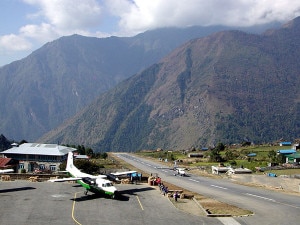Tenzing-Hillary Airport thrilling, dangerous but still stands big

KATHMANDU, Nepal- At an altitude of 2,843 meters (9,325 feet), the small airstrip, Tenzing-Hillary Airport in Lukla has earned a reputation as one of the most extreme and dangerous airports in the world. The single runway that is narrow, short and sloped has made it dangerous as miss the runway by a few meters (or feet) and the plane would hit a mountain.
And that may be the reason that as soon as the decades-old Twin Otter landed at Lukla airport, passengers burst out in applause. They do that for nearly every safe landing at the often terrifying airport at the gateway to Mount Everest.
But despite the fact the airport, earlier known as Lukla Airport, has its own importance for the region. The airport is now the second busiest airport in Nepal after Tribhuvan International Airport in Kathmandu.
According to the airport, it has handled up to 79 flights on one day — far beyond the acceptable capacity for such a facility.The thousands of mountaineers and trekkers who visit the Everest region have to fly to the airport if they want to avoid a daylong bus trip from Kathmandu and five days of trekking to reach the place, which is one the most visited places in the world.
“After you cross the river there is no turning back, you have to land,” a Associated Press report quoted Pramod Poudel, a Tara Air pilot who has flown hundreds of these flights to Lukla as saying.
According to Poudel, the pilot need to concentrate hard when landing on the single runway, which is less than 500 meters (yards) long, slopes some 12 degrees and is barely 20 meters (65 feet) wide.
“Because there is no way to go around again, we have to calculate many things like air speed, tail wind, fog,” he said. “If you don’t do the proper calculation or proper exercise, then it” — meaning an accident — “happens.”
The airport can only handle special short take-off and landing (STOL) aircraft like the Twin Otter or Dronier that take about 18 passengers. It has room for only four of these planes to be parked at one time.
The runway is one-way for both takeoff and landing. Aircraft have to land from the southwest and take off toward the northeast because at the end of one side of the runway is a mountain. When winds are blowing in an unfavorable direction, all takeoffs and landings have to stop.
Carved out of the side of a mountain, the airport was built by Sir Edmund Hillary in 1965 — 12 years after he became the first man to conquer the world’s highest peak — to help the local yak herders known as Sherpas spur development in the impoverished area.
“It is really challenging, because of the geographical location of the airport and high mountains that surround it. Topography is challenging and the traffic volume is challenging,” Rinji, an air traffic controller at the airport told AP. “There is little space for aircraft to maneuver because of the high mountains and narrow valley.”
And these crashes have made the airport thrilling and dangerous. In 2008, 18 people were killed when a Twin Otter plane belonging to the domestic Yeti Airlines smashed into the side of the runway and caught fire while trying to land in heavy fog. Investigators said the pilot should not have attempted to land in those conditions.
In August 2010, 14 people were killed when a Dronier belonging to the domestic Agni Air crashed after it was forced to turn around due to bad weather conditions at Lukla. In May 2004, another Yeti Airlines Twin Otter crashed while approaching Lukla, killing all three occupants in an accident blamed on heavy cloud buildup and pilot misjudgment.
One plane was unable to stop on the short runway and smashed into a wall. Another skidded off the runway. A third lost its front landing gear as it tried to land and skidded down the runway, forcing the airport to shut for two days. No one was killed in those crashes. (with inputs from the AP report)

